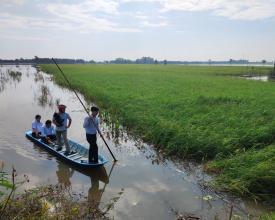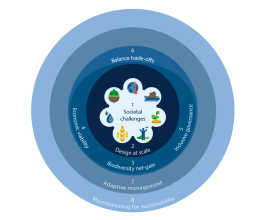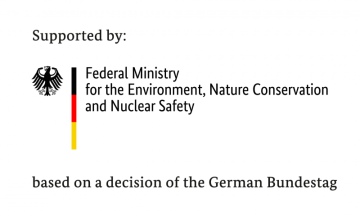
Flood-based agriculture in the Upper Mekong Delta
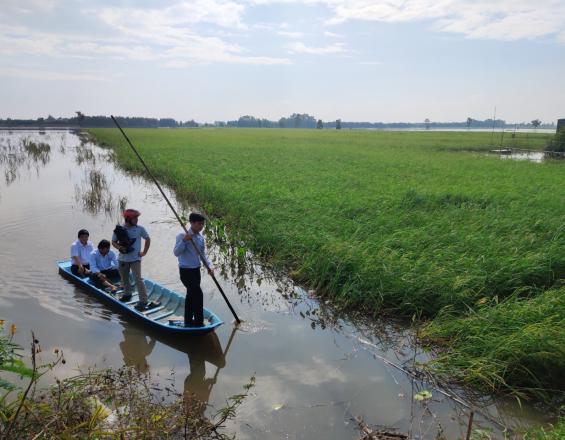
IUCN promoted and improved locally-practiced, flood-based (wetland) agriculture and livelihood models in the Vietnamese provinces of An Giang, Dong Thap and Long An. These practices were based on documented farmer knowledge and experience. Flood-based livelihoods were encouraged as a financially viable, low risk alternative to triple rice cropping (the dominant agricultural practice). They help enhance economic and climate resilience as well as conserve and restore the biodiversity found in Mekong Delta freshwater wetlands/floodplains. The intervention employed a Nature-based Solution and considered three systems - floating rice systems, lotus farming systems and rice aquaculture systems. In addition, due to increasing weather extremes, hybrid solutions were also explored (combination of dykes and floodplains). Hybrid models can better enable controlled flooding and adaptive approaches to overcome risks of drought and to manage the arrival and recession of floods to be more in tune with cropping needs.
Context
Challenges addressed
Triple rice mono-cropping by poldering has been the dominant agricultural practice in the floodplains of the Mekong Delta. This practice caused significant losses of the seasonal floodplain in the Delta as well as a decline of ecosystem functions, including reduced land fertility, declining flood resilience and decreased aquatic habitat and biodiversity. The negative impacts caused by increased flood risk also resulted in transboundary challenges between Vietnam and Cambodia. To address these challenges, the concept of flood-based agriculture as a Nature-based Solution emerged as part of a larger Programme of Work starting with the 2013 Mekong Delta Plan, which leveraged a number of projects that explored its feasibility. Initial studies of farmer initiatives and proof of concept in IUCN pilot sites were completed between 2015 and 2018. These fed into the design and implementation of similar projects in the region (e.g. those by the World Bank, IUCN and FAO).
Location
Process
Summary of the process
The building blocks highlight a number of key insights that emerged from the assessment of the flood-based agriculture intervention in Vietnam against the criteria and indicators of the IUCN Global Standard for Nature-based Solutionsᵀᴹ. While they do not give a full picture of what can be considered a Nature-based Solution as all criteria in the Standard are of equal importance, they illustrate some of the factors that made the introduction of this new farming model successful and highlight important next steps to increase uptake and scale-up, and ensure financial sustainability.
Building Blocks
Building the intervention around supportive legal and policy frameworks
The Nature-based Solution intervention built on the 2013 Mekong Delta Plan, which recommended high-value double rice cropping in combination with seasonal flood-based agriculture/aquaculture to manage flood risks. This influenced the promulgation of National Resolution 120, entitled “For a sustainable and climate resilient Mekong Delta”. The resolution was adopted in November 2017 and stipulates that nature-based adaptation models should be selected that are environmentally sound and achieve sustainable development based on ‘actively living with the floods’. In addition, the annual Mekong Delta Forums bring together governments and development partners. They provide a space for knowledge exchange on lessons learned and endorsement of a common vision for the Upper Mekong Delta, including a move to more natural land and water uses.
Enabling factors
The 2013 Mekong Delta Plan captures the range of societal challenges and benefits and supported the implementation of flood-based agriculture systems. The societal challenges include loss of the Mekong Delta floodplain and thus flood absorption capacity due to intensive rice growing by poldering, reduction of land fertility and aquifer recharge area, decline of aquatic habitats and biodiversity as well as growing socio-economic inequality due to greater input costs to compensate for increased pest risk, lost fisheries, sediment and soil fertility.
Lesson learned
Supportive legal and policy frameworks opened up opportunities for a change in land use and facilitated partnerships across related initiatives for the adoption of flood-based agriculture in open flood and flood control zones.
Enhancing collaboration between various projects to increase impact at scale
The design of the intervention recognised the challenges across the Mekong Delta, which were also captured in the 2013 Mekong Delta Plan. The Nature-based Solution intervention strategically addressed knowledge gaps, capacity needs of farmers and regional planning challenges, working collaboratively with other similar initiatives. The intervention responded to interactions between the environment and society in terms of improving livelihoods through flood-based agriculture. While initial IUCN pilot interventions remained limited and small-scale, collaboration across similar projects and recent policy developments currently support the development of a large-scale intervention across the 1.4 million ha of the Upper Mekong Delta floodplain.
Enabling factors
Lessons learned from the IUCN pilots and experiences from other similar initiatives are shared regularly at the Mekong Delta Development Partners Working Group and Annual Mekong Delta Forums. Further, the emerging interest from academia in flood-based agriculture is already producing relevant data and information and enhancing collaboration and partnerships.
Lesson learned
A hybrid system of flood-based agriculture with some flooding control system of low dykes could help manage risks of early/heavy floods and droughts. The highest potential lies in the closed flood zones with high dykes through the opening of sluices during seasonal floods to restore the flood retention area. However, existing projects have not yet addressed this potential. This demonstrates that for Nature-based Solution interventions to achieve positive impacts at scale, small-scale (often focussed on pilots), project-based and time-bound interventions are not sufficient to address complex societal challenges. Nevertheless, partnerships between related interventions in the region contributed to institutional and policy development as well as supported greater cross-sectoral coordination. In addition, an IUCN-led Green Climate Fund proposal is under preparation to increase uptake, ensure continuity of efforts and to address transboundary challenges.
Financial support to transition to flood-based agriculture
Several cost-benefit analyses provided insights into the main trade-offs between different agricultural systems. To compensate farmers for conserving and restoring ecosystem services of the floodplains, they received support to cover the costs of the transition to flood-based agriculture and resist pressures to convert additional low dyke areas into closed control zones with high dykes that would exclude the land from flooding. In some areas a hybrid model was used, with low dykes controlling the timing of flood arrival/recession to support double-cropping and flood-based cropping (instead of the traditional third rice crop). In the case of lotus farming systems, flood-based agriculture enabled diversification of activities, including fish raising, ecotourism and recreational opportunities.
Enabling factors
A feasibility study revealed that several hundred thousand farmers and a number of downstream towns would benefit financially from flooding if seasonal flood-based agriculture were applied. In addition, cost-benefit analyses were carried out on the profitability of flood-based crops and the cropping system as a whole in comparison to mono-rice cropping.
Lesson learned
In the future, value chains, especially for rice production, will need to be considered in more detail to support the new flood-based agriculture model and gain support from rice exporters. Consideration of the value chain would ensure the economic feasibility of the flood-based livlihood model and provide an incentive for its uptake. Through consultations and analysis of lessons learned, market access and a lack of value chain development were identified as the greatest challenges for scaling up flood-based agriculture. This is already taken into account in the design of a future Green Climate Fund project.
Impacts
The main positive impacts of employing flood-based agriculture in the Upper Mekong Delta include improved flood risk management through enhanced ecosystem functions of floodplains. The conservation or restoration of flood retention capacities supported aquifer recharge, a reduction in land subsidence and the conservation or restoration of aquatic habitat/biodiversity. Additional positive impacts include the possibility of wild fisheries, mitigation of river erosion through the re-establishment of natural hydrology of seasonal flooding and increased land fertility, including through sediment deposition due to the seasonal flooding.
Beneficiaries
primarily local farmers, government representatives
Sustainable Development Goals
Story
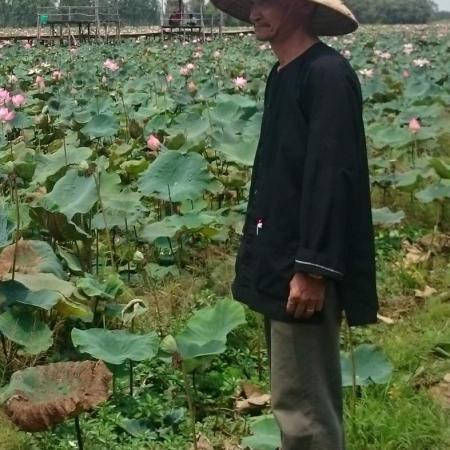
In 2016, the Flood Retention Strategy for the Mekong Delta was proposed, which allows provinces to plan in a more coordinated manner across floodplains and to protect ecosystems. Flood-based livelihood models, such as lotus farming, floating rice systems and rice-aquaculture, are included in the Strategy as financially viable options for farmers.
Conversion to flood-based agricultural practices have numerous benefits for local farmers. Intensive lotus farming has already demonstrated that the increased storage of flood water (approx. 1,500 m³ per 1,000 m²) has increased the abundance of fish, crab and water birds. Moreover, there is no longer a need for chemical or pesticide use.
The benefits of this Nature-based Solution have also been recognised by local farmers:
Mr Nguyen Ngoc Hon, an experienced lotus farmer from MyHoa commune, Thap Muoi District, said: “I strongly believe that the farmers in the high dyke areas will be willing to convert to lotus farming models if the profit from lotus is higher than rice cultivation, so the flood retention strategy is a feasible target. Of course, lotus farming can hold more water than rice cultivation. Therefore, it helps to regulate the environment better. I think the lotus models can adapt with climate change impacts because it can deal with floods and droughts as well. Planting lotus produces higher incomes while it is better for the environment!”
